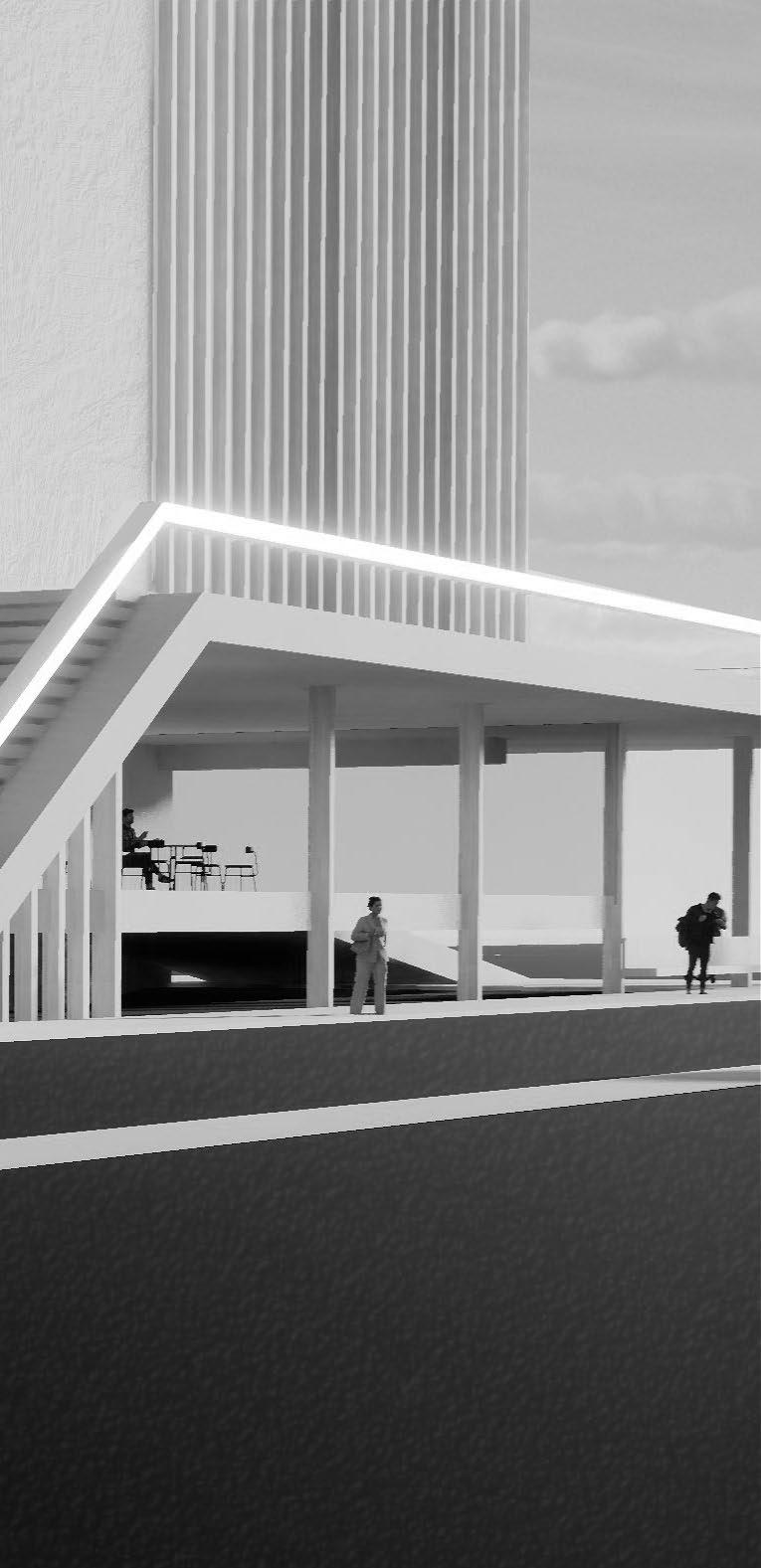




[2019 - MAY 2024]
[2022]
BACHELOR OF ARCHITECTURE : B.Arch
Tau Sigma Delta National Honor Society
Marywood University School of Architecture (MUSOA), Pennsylvania
3.9 GPA
STUDY ABROAD
ISI Florence, Italy

I am a dedicated fifth year architecture student seeking a position upon graduation, eager to embrace a new opportunity and further elevate my expertise. Having resided in England, Bermuda, and the U.S., I have overcome unique challenges and have drawn from my various cultural experiences. I pride myself in being highly adaptable, committed and always seeking to learn. I am excited to begin this new chapter, collaborating with like-minded individuals to create meaningful architecture.
[2023]
STRADA LLC ARCHITECTURE INTERN .
PITTSBURGH
Drafted floor plans and RCPs for commercial projects Created digital base plans on current building conditions for partnering engineers Surveyed project site condition Communicated and collaborated with other architects, performed assigned duties Consulted with clients and adapted based on client’s preference Performed punch listing for project closeout . .
[2024]
NATIVITY MIGUEL SCHOOL ARCHITECT STUDENT TEACHER .
SCRANTON
[2022]
PHONE + 1 (484) 719 1375
EMAIL rye.ahronson@gmail.com ADDRESS
2108 Menold Drive Allison Park, PA 15101
ADOBE
Created engaging architecture lesson plans for middle school aged students Implemented lessons and facilitated learning through group instruction Provided age appropriate critiques and aided progression of skills
ST. JOSEPH’S COMMUNITY EVENT DESIGN TEAM . INTERNATIONAL FINANCIAL PLANNING LTD. GRAPHIC DESIGNER
BERMUDA SCRANTON
[2020] .
Consulted with client about goals and requirements for event Surveyed event site and measured spaces Produced drawings of functional event layout . . . . . .
Designed letterheads and watermark stamps for certification Developed presentations to showcase company logo and data processing systems
[2023]
[2023]
[2022 - 2023]
[2019 - 2024]
AIA PENNSYLVANIA STUDENT AWARD
Excellence In Architecture
MARYWOOD SoA EXHIBITION
4th Year
STUDIO AWARD
3rd & 4th Year
DEANS LIST
Spring & Fall Semester
[2020] SPRING COMPETITION MUSOA
[2019] SALUTATORIAN
Valley Forge Military Academy


College campuses often explore visual likeness for their buildings, whether they are administrative, educational or housing; however this becomes their only connection. The idea of a campus is to create an environment that students feel secure and integrated within their housing, and their classrooms, while also creating relationships with fellow students. With The University of Scranton growing its student population, space around campus is shrinking. With empty lots, an addition to the university’s campus is made available. Trium explores the way in which three separate buildings and their differing uses can still find a way to be connected. A below ground chapel creates a focal point to the site, with the surrounding School of Business and dormitory complementing the organic shaped roof. The buildings follow the traditional use of materials found around the rest of the University of Scranton Campus making the trio of buildings sit seamlessly into the campus. The site itself aims at creating an immersive environment for students, faculty and the rest of the local community. Providing a coffee shop, grocery store and community chapel, the plaza creates a gathering space for students to meet with others and feel connected.










Mechanical Louvre Connection
Wood Finish Louvre

Curtain Wall
Steel Mullion
Stainless Steel Extruded Top Rail
Structural Toughened Glass
Setting Block
Floor Finish
Concrete Slab
Dropped Ceiling/ Wire Space
Concrete Load Bearing






The three buildings explore the connection beneath ground. From above, the buildings seem disconnected but have connections both within structure, and movement on the site.

The main areas on the sites plaza provide students with public gathering spaces and community engagement.

The main idea stems from a central axis that flows through, both above and below the site. This axis connects the buildings and the site.

Double facades act as partitions for student privacy, as well as a mode of sun control, or diversion.

Each of the structures provide a full glass curtain wall to absorb as much of the Scranton sun as possible.

Viewpoints are a major feature of the building’s experience of the site and downtown for the user.



In the United States alone, thirty to forty percent of all food is wasted per year. This percentage equates to $161 billion of wasted product. Food waste occurs at all levels of the food production and distribution cycle. With these numbers increasing as the production amounts rise, food waste is becoming harder to limit and control. With recent exploration of technology, there are demonstrations of food waste being manipulated to create concrete. The three steps to producing this building material are simple: dry the food waste, crush it into a powder, and finally heat-press it into a mold. This method is proved to make concrete that is four times as strong as that produced through traditional concrete methods. Further, this formula decreases carbon dioxide production by keeping food out of landfills and avoiding conventional concrete production (which contributes to 8% of CO2 emissions). By utilizing food-waste concrete in place of traditional concrete, architects can serve to provide food waste with a second life and a new story, as well as contribute to sustainable practices. Implementing foodwaste concrete as the main building material, this project aims to set foundations for the community in promoting the reuse and management of food waste. This building is designed as the base structure, with a goal to jump start a web of future food-waste structures that would create a visual representation of Binghamton’s food waste over the years. Currently in Binghamton the riverfront is rarely used; this building serves to promote the exploration of new sights within the community by offering an immersive experience in the surrounding nature. This project provides a reason for people to place themselves on the city’s river edge and explore the nature and biodiversity of species. Ultimately, this building allows users to escape the hustle and bustle of the city and expose themselves to a therapeutic environment. Further, it aims to start small in countering the nation’s food waste problem in the Binghamton area in hopes to encourage similar projects throughout the world.







The form derives from a basic rounded rectangle. With the removal and shifting of individual programs, it creates a multi dimensional space for use and user experience. Private sectors are separated through a shift and public educational spaces are combined and connected within the central axis. Circulation and movement is forced on the exterior, as the user is led from one mass to another.








In Florence, Italy, architecture is sacred. The zoning is strict and allows a flow from one street to another. A sense of exploration and reveal is forced upon residents and visitors along with an aura of romance and culture. The vibrant colored facades paint art on the streets. The gridded out windows create a consistent pattern and rhythm. The idea of ‘new’ architecture can be considered forbidden in such a culturally focused city. Inclusion tests that theory. A modern housing complex for study abroad students allows for immersion into the city of Florence and its culture. Inclusion derives its design from the importance of intergenerational and cultural significance. Within the structure, space is created by upholding these key concepts. Large community gathering spaces and vantage points are integral to the design. By limiting living spaces and emphasizing togetherness, the intended result comes to fruition. A glass curtain wall reflects and adapts to its surroundings, ultimately placings itself in the environment. The colorful facades reflect on each glass panel and will continually change with time. The structured window placement of nearby buildings flow into this project, as the windows follow this strict pattern and promote unity. Each window becomes operable to allow the outside sounds and environment to flow in, while also respecting privacy. The second facade forms a sheltered interior/exterior space for users. A central courtyard creates the main gathering space for students and visitors to connect and integrate. Although a very modern approach, Inclusion blends seamlessly into the city.








The public walk through connects the two streets, as well as creates a cantilevered aspect to the structure.

Behind the visible glass facade, interior balconies are created for a moment of fresh air, while still being protected from the elements.


The interior balconies create an open cavity that flows from the 2nd floor to the roof.
The building sits within its surroundings, connecting the two streets and providing an alternate circulation around the area.




Clay Roof Tiles
Water Insulation Barrier Membrane
Wood Battens 50 X 25 Mm
Reinforced Concrete Beam/ Slab
Structural Steel Column
Suspension Cables
Frosted Glazed Glass Panel
Carbon Steel “L” Bracket
Steel Hand Rail/ Window Bracket

Carbon Steel “L” Bracket
Window Mechanism
Brick Stones
Vented Air Space
Insulation
Concrete Columns
Plaster Finish
Floor Finish
Concrete Slab
Dropped Ceiling/ Wire Space
Concrete Load Bearing

Double

This project focuses on designing an addition for a current residential building. Given a hypothetical client with specified needs and limitations, wall sections and section details were added to bring the design to fruition










In order to reignite the idea of public transport, first it must be made attractive to the user beginning with alterations to the bus stops. A bus stop becomes the hub, either the beginning or the end of a journey. It acts as shelter and protection against varying climates and becomes vital when attempting to promote the use of public transport. In order to further grow the use and appeal of bus stops there must be a destination or reason to use them. Joined and blended into the facade of JCPenney (Viewmont Mall), Fuzed art gallery attempts to revitalize Scranton and introduce a new hot-spot for visitors and locals. The high ceilings provide a place for large sculptures and art pieces to be displayed. In addition to art exhibits, a rooftop garden produces spectacular views of the mountain ranges that flow through the Dickson City area.




















